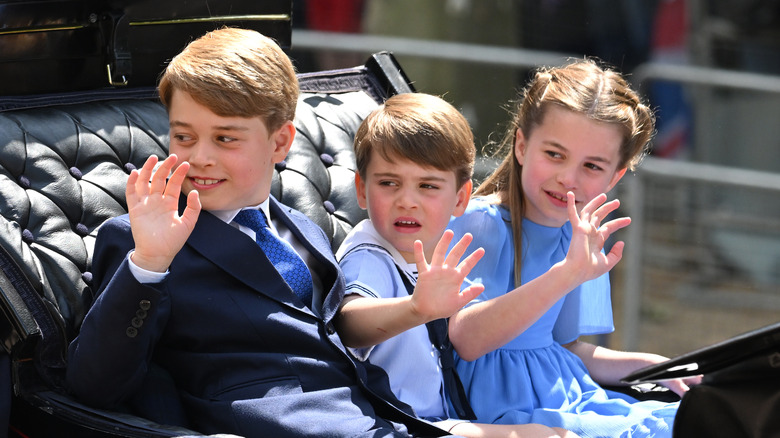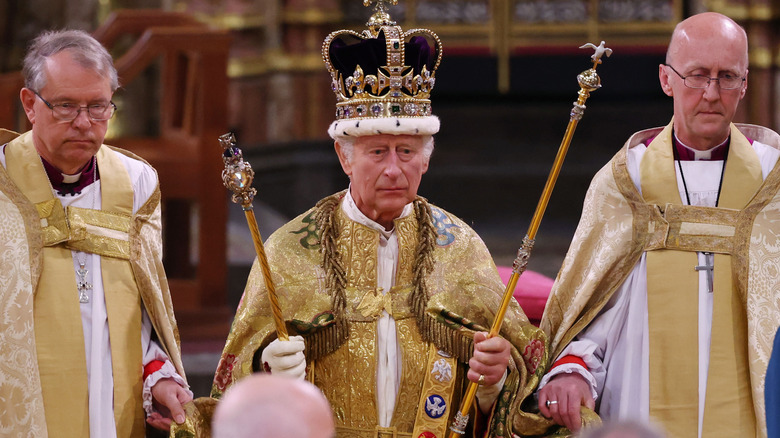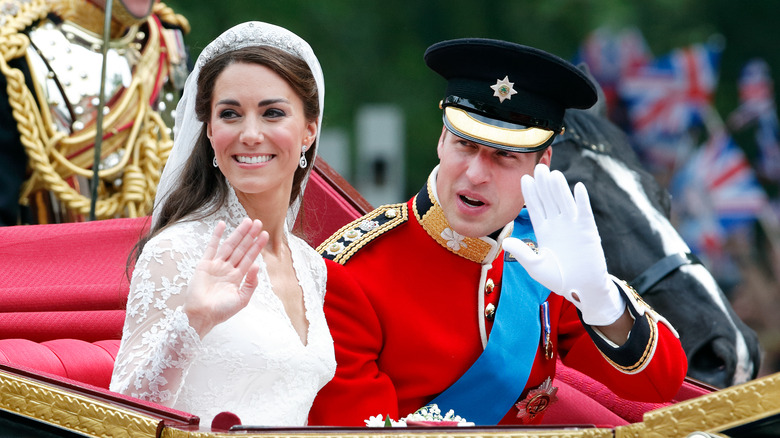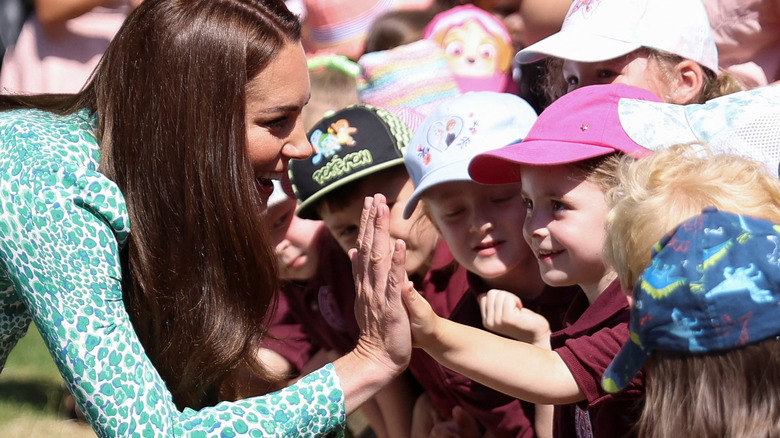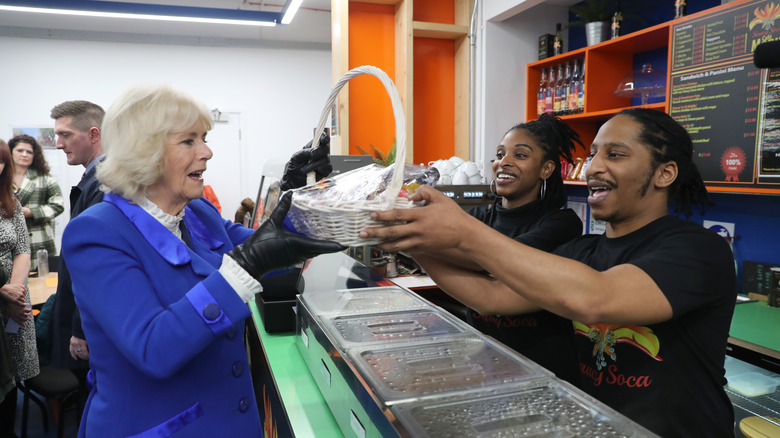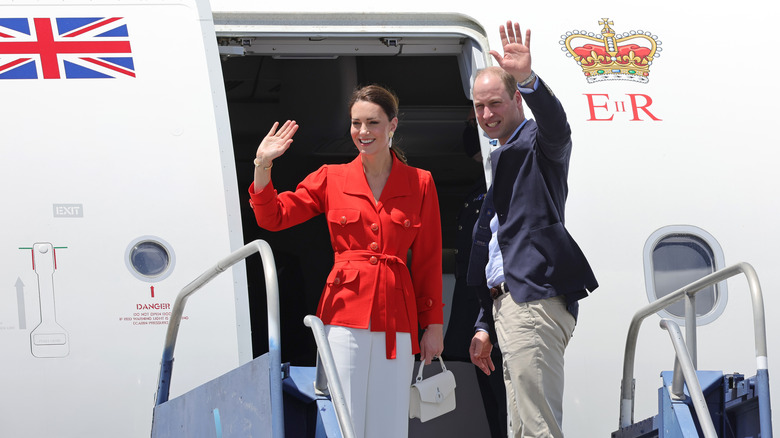Things Prince George And Prince Louis Can Never Do In Their Lifetimes
When we think of the British Royal Family, we might think of all the pomp and circumstance that surrounds their life events like weddings, funerals, and coronations; we might think of the fabulous fashion that they're lucky enough to wear; we might think of the countless homes they have across multiple countries. But all of this privilege comes with some hangups and rules that royal fans might not be aware of.
Because the monarchy stretches back so many centuries, it makes sense that even though the current royals have taken steps to modernize the firm and bring its values and expectations into the 21st century, some rules that might seem outdated or strange are still hanging on. While the average citizen of the United Kingdom is likely to be able to choose who they marry, who they fly on a plane with, and which religious institution they do or do not want to be a part of, the same is not true for some members of the royal family, like the young princes George and Louis, children of William and Catherine, Prince and Princess of Wales.
Monarchs must be part of the Church of England
While this might surprise people living in the United States, where religious freedom is guaranteed for all people, including the leaders of government, the sovereign of the United Kingdom is required to be "in communion" with the Church of England (via University College London). This rule dates all the way back to the days of the infamous King Henry VIII, who himself became the first head of the Church of England after the Reformation, when England separated from the Roman Catholic Church.
Still to this day, the sovereign is named the Church's 'Supreme Governor," and as such, the King or Queen of England is not allowed to break from the Church of England or to be a Roman Catholic or any other religion. Because Prince William is next in line to the throne, this rule applies to him, and because his eldest son Prince George is in line for the throne after him, this rule is likely to apply to him as well.
Potential future monarchs require permission to marry
Another rule that will apply to George, Charlotte, and Louis dates all the way back to The Royal Marriages Act of 1772 (via Encyclopedia.pub). This act of the Parliament of Great Britain imposed conditions under which members of the royal family were allowed to legally marry. At the time, the sovereign was given the right to veto any proposed marriage of any member of the royal family in an effort to protect the firm from any marriage that might "diminish the status of the royal house."
Obviously, in the modern age, this feels immensely outdated, and so in 2011, the Perth Agreement made an adjustment to this part of the act. Under the Succession to the Crown Act of 2013, the new rule is that the first six people in the line of succession require permission from the monarch to get married if those members of the family would like their future children to be included in the line of succession. In other words, these members of the firm don't technically have to get approval from the King or Queen to marry, but if they want their children to be in line for the throne, they do.
Because all three of William and Catherine's children are within the first six people in line for the throne, this rule will apply to all of them unless something changes in the future.
They can't sign autographs
While fans of famous people are accustomed to asking for autographs in the event they meet their favorite celebrity, royals fans are likely to be disappointed in this regard, as members of the royal family cannot sign autographs (via US Weekly). Considering the signatures of high ranking royals are used to sign major documents including those pertaining to laws and international relations, it makes sense that it wouldn't be wise to allow just anyone to have access to those signatures lest they be forged. But that hasn't stopped Catherine, Princess of Wales, mother to George, Charlotte, and Louis, from finding creative ways around that rule.
When Kate attended the Chelsea Flower Show in London this past spring, a little girl asked her for her autograph. In response, she said, "My name's Catherine. I'm not allowed to write my signature, it's just one of those rules," but then she offered her young fan something else, saying, "I can't write my name, but I can draw." She then drew a flower for the child, and she drew other images like a tree and a pond for two other children.
We imagine that the royal children will learn this graceful way around the rule for their fans as well.
Accepting major gifts is complicated
According to a set of rules and policies that were written in 1995 and updated in 2003, there are some types of gifts that members of the royal family are allowed to accept and keep as personal items, while others need to be accepted in an "official" capacity and do not belong to the recipient personally (via The Evening Standard). It all depends on who gives the gift to the royal, and how much that gift is worth.
Any gift a royal receives in the line of their official duties, meaning a gift from a dignitary or head of state, a gift given during an official event, or a gift otherwise given to them in their official capacity is not the property of that individual. Instead, as a representative of Buckingham Palace explains, "Official gifts are not the personal property of the member of the Royal Family who receives them, but may be held by the sovereign in right of the crown or designated in due course as part of the royal collection."
Personal gifts, on the other hand, meaning gifts given by people the royal in question personally knows, belong privately to the individual who receives them. The only exception to this rule is if the gift is given in a personal capacity but is given by a person with an official role, that gift cannot be worth more than £150. If it is, then it is considered an official gift and follows those rules.
No two heirs to the throne can fly together
This last rule is a logical one, if rather morbid. In an effort to try and keep the line of succession intact and the senior members of the royal family safe, two direct heirs to the throne are not supposed to fly together on the same plane in case, heaven forbid, something catastrophic should occur during travel (via Express).
Because William is next in line to the throne, his eldest child, George, is in line directly after him. For this reason, Queen Elizabeth II had not wanted William and George to fly together in observance of this customary rule. However, William and Catherine have opted on some occasions not to separate George from his father on family trips. That said, when George turns twelve, that will change.
When George is twelve, he will officially no longer be allowed to fly together with his family, as two or more heirs are never supposed to fly on the same craft together, and twelve is the age when this rule becomes non-optional in an effort to maintain the stability of the monarchy and the succession.
